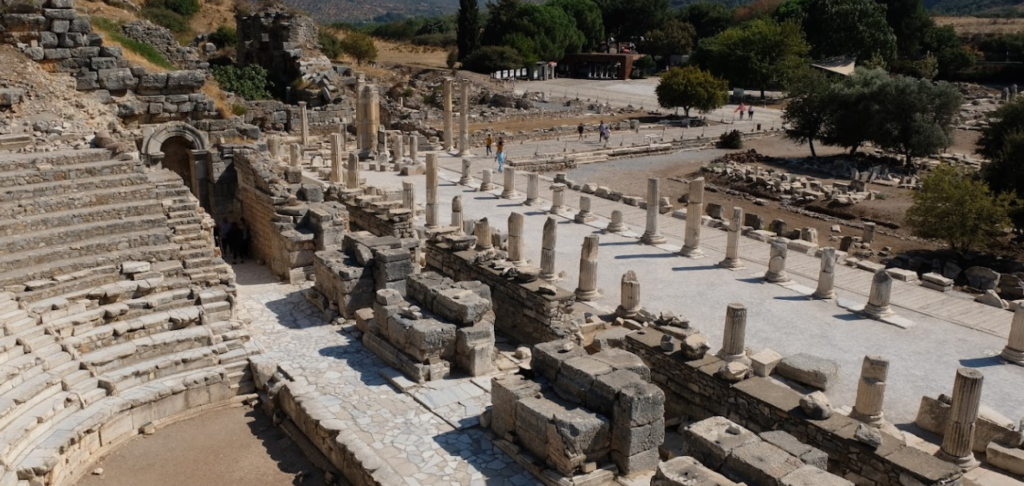Ephesus Archaeological Site: The Ancient Jewel of Asia Minor

The Ephesus Archaeological Site, located near Selçuk in modern-day Turkey, is one of the best-preserved and most significant ancient cities in the world. Once a thriving center of commerce, culture, and religion, Ephesus offers visitors a chance to step back into the grandeur of ancient times. From monumental temples to intricate mosaics, this UNESCO World Heritage Site is a testament to the ingenuity and artistry of its creators.

A Historical Overview of Ephesus
Early History
Ephesus, believed to have been founded in the 10th century BCE by Ionian Greeks, was built near the ancient site of the Arzawa Kingdom. According to legend, the city’s location was chosen based on the guidance of an oracle of Apollo, where a fish and a wild boar signaled the site for its foundation.
Classical and Hellenistic Periods
Under Lydian King Croesus in the 6th century BCE, Ephesus flourished and became known for its wealth. The city came under Persian control before being liberated by Alexander the Great in the 4th century BCE. During the Hellenistic period, Ephesus reached new heights of prosperity as its harbor connected it to Mediterranean trade routes.
Roman Ephesus
By the 1st century BCE, Ephesus became a key city of the Roman Empire and the capital of the province of Asia Minor. It was during this period that Ephesus witnessed the construction of its most iconic structures, including the Library of Celsus and the Great Theatre. The city also became an early center for Christianity, with St. Paul and St. John preaching here.
Decline and Abandonment
Ephesus began to decline after the harbor silted up, cutting off its access to the sea. Combined with invasions, earthquakes, and the rise of other trade centers, the city was gradually abandoned by the 15th century CE.

Exploring the Site: Key Highlights
1. The Library of Celsus
One of the most photographed monuments of Ephesus, the Library of Celsus, was built in 117 CE in honor of the Roman senator Tiberius Julius Celsus. Its ornate façade, featuring Corinthian columns and statues, once housed over 12,000 scrolls, serving as a symbol of knowledge and culture.
2. The Great Theatre
This massive structure, capable of seating 25,000 spectators, was the heart of public life in Ephesus. The theatre hosted dramatic performances, political gatherings, and gladiatorial contests. It is also famously associated with St. Paul, who preached here against the worship of Artemis.

3. The Temple of Artemis
Once considered one of the Seven Wonders of the Ancient World, the Temple of Artemis was a monumental structure dedicated to the city’s patron goddess. Although only a few columns remain today, the temple’s historical significance and architectural grandeur continue to captivate visitors.
4. The Terrace Houses
Located on the slopes of Mount Bülbül, these elite Roman homes provide a glimpse into the luxurious lifestyles of Ephesus’ wealthiest citizens. Intricate mosaics, frescoes, and marble panels showcase the artistry and sophistication of the time.
5. Curetes Street
This bustling ancient street, lined with marble paving stones, was a hub of activity in Roman Ephesus. Visitors can explore remnants of shops, fountains, and monuments, including the Hercules Gate and the Temple of Hadrian.

6. The Basilica of St. John
Although technically outside the main archaeological site, the Basilica of St. John in nearby Selçuk is closely tied to Ephesus’ history. Built over the tomb of St. John the Apostle, it was a major pilgrimage site in Byzantine times.
Ephesus and Early Christianity
Ephesus played a significant role in the spread of Christianity. St. Paul spent several years in the city, addressing letters to the Ephesians that later became part of the New Testament. According to tradition, the Virgin Mary spent her final years near Ephesus, in a house on Mount Koressos. The House of the Virgin Mary remains a sacred pilgrimage site to this day.

Preservation and Archaeology
The excavation of Ephesus began in the 19th century and continues today. Austrian and Turkish archaeologists have uncovered only a fraction of the city’s remains, revealing new insights with each discovery. Major restoration efforts, such as those on the Terrace Houses, ensure that the site remains accessible for future generations.
Practical Tips for Visiting Ephesus
- Best Time to Visit: Spring (April-May) and autumn (September-October) offer the most pleasant weather for exploring the site.
- Guided Tours: Hiring a guide or joining a tour enhances the experience, providing historical context and fascinating stories about the city.

- Wear Comfortable Shoes: The uneven marble streets can be slippery, so sturdy footwear is essential.
- Bring Water and Sun Protection: The site is expansive and lacks shaded areas, so hydration and sunblock are a must.
- Plan Extra Time: To fully appreciate Ephesus, allocate at least 3-4 hours for your visit.
A Timeless Journey Through Ephesus
Visiting the Ephesus Archaeological Site is more than just exploring ruins; it’s a journey through the epochs that shaped Western civilization. From the echoes of ancient festivals at the Temple of Artemis to the profound silence of St. John’s Basilica, Ephesus captivates history enthusiasts and casual travelers alike.
Whether you’re drawn by its architectural wonders, its role in early Christianity, or its place in the ancient world’s cultural tapestry, Ephesus promises an unforgettable experience. Step into the past, and let the stones of this ancient city tell their timeless stories.